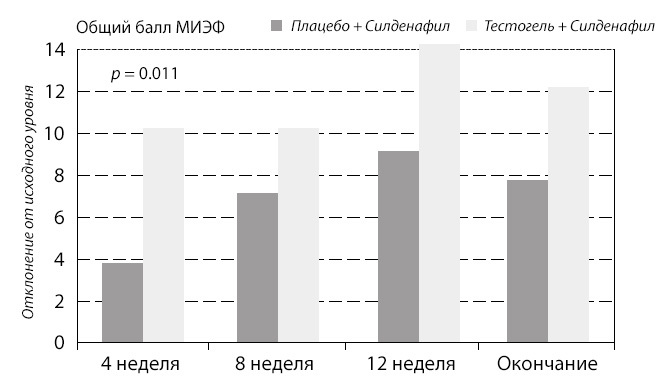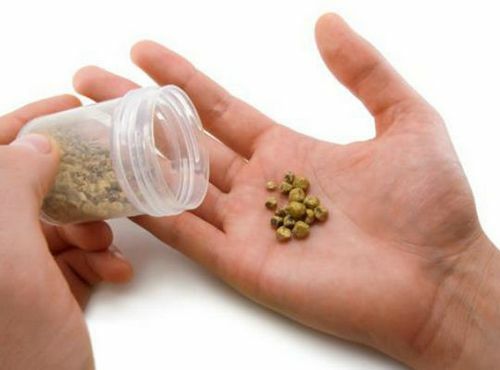Treatment of erectile dysfunction in androgen deficiency
If a man has a sexual dysfunction due to androgen deficiency, as well as erectile dysfunction( ED), treatment should begin with the normalization of testosterone levels. Normalization of the level of androgens by the administration of hormonal drugs( for example, testosterone undecanoate), significantly increases the effectiveness of the use of phosphodiesterase type 5 inhibitors( PDE-5) and the results of ED therapy.
Effect of testosterone on the erectile function of
Some scientific studies also demonstrate the effect of testosterone on erectile function: after recovery of testosterone levels, a significantly better response to Sildenafil therapy( 100 mg) was observed compared with men taking sildenafil and placebo( Figure 1).

Fig.1 - Change in erectile function( ICEF-5 score) in men with hypogonadism receiving Sildenafil and placebo( 1st group) and Sildenafil and Testogel( 2nd group)( according to Shabsigh R. et al, 2004).
In case of ineffectiveness of monotherapy aimed at elimination of adrenal deficiency, in relation to the normalization of sexual function, it is advisable to combine hormonal therapy with the intake of vasoactive drugs. The use of vasoactive drugs should be started no earlier than 1-1.5 months. After restoring the normal level of testosterone. This sequence of treatment is due to the role of testosterone, as the main catalyst of sexual arousal - the first and main stage in the occurrence of an erection. In addition, according to recent data, androgens are involved in the process of maintaining the production of nitric oxide( NO2), which is necessary for the erection.
Modern medical concepts indicate that testosterone can directly affect the structure of cavernous bodies and nerves. This is confirmed by an experiment on animals, when castration led to a change in the structure of the cavernous nerves.
A number of studies have confirmed that a decrease in the level of androgens provokes an increased deposition of fat cells in cavernous bodies. This prevents the mechanism of erection initiation due to venous insufficiency, a decrease in blood flow and elasticity of cavernous tissues.
Despite a few observations, even now it can be argued that the treatment of ED in patients with hypogonadism with testosterone preparations leads to normalization of the structure of cavernous bodies, improvement of blood flow and elimination of venous insufficiency, and, as a result, restoration of erection or increase in the effectiveness of PDE-5 inhibitors. Monotherapy with PDE-5 inhibitors in such cases is ineffective.
Low level of testosterone plays an important role in the onset of ED:
- reduction in relaxation of smooth muscle cells of cavernous tissue;
- reduction in NO2 production;
- increased apoptosis of smooth muscle cells;
- increase in the number of adipocytes;
- decrease in sexual desire.
Since the therapy with vasoactive drugs is symptomatic, i.e., aimed at eliminating the symptoms of the disease and does not eliminate the factors that cause erectile dysfunction, they are classed as second-line drugs in the treatment of erectile dysfunction in men with androgen deficiency. Although recently there are new data on the therapeutic effect of Viagra, the most popular representative of the class of PDE-5 inhibitors, when administered daily for the night in the course mode for at least 1 month.
Of the vasoactive drugs that affect the occurrence of erection, prefer phosphodiesterase type 5 inhibitors( Viagra, Cialis, Levitra) as a drug having a high enough efficiency( 70-80% depending on the underlying and accompanying diseases), not decreasing with prolonged use. Preservation of efficacy and safety of vasoactive drugs with long-term use is extremely important, since the symptomatic nature of therapy with organic forms of ED implies their permanent( lifelong) reception.
Viagra and Cialis are today drugs that have shown their effectiveness in combination therapy with androgens. To understand the mechanism of action of PDE-5 inhibitors, as well as the role of testosterone in the development of their effect and possible inefficiency with decreasing testosterone content, knowledge of the mechanism of erection is necessary.
Erection mechanism
Erection is a vascular reaction that occurs in response to sexual stimulation. In a complex mechanism of erection, a significant role is played by nitrogen oxide, which is released from the nerve and endothelial cells in response to sexual arousal. Further, nitrogen oxide diffuses through the membrane of smooth muscle cells and increases the activity of guanylate cyclase, which stimulates the production of cGMP in the tissues of the penis. CGMP is an intracellular messenger that affects the decrease in cytosolic calcium, which stimulates contractile processes. The end result of the action of nitric oxide is a relaxation of smooth muscles and an increase in the arterial influx.
The destruction of cGMP occurs under the action of a specific for cavernous tissue enzyme - phosphodiesterase type 5.Inhibitors of PDE-5 exert their effect by increasing the effect of nitric oxide, released in response to sexual stimulation.
Thus, PDE-5 inhibitors are not stimulants, but rather modulators of erection, as they contribute only to the strengthening of physiological processes aimed at the emergence and maintenance of an erection in response to sexual stimulation. In the absence of sexual arousal, observed with a decrease in sex hormones, the appointment of PDE-5 inhibitors is not advisable, since there will be no "start" of the mechanism of the erection leading to the release of NO, an increase in cGMP content, whose concentration is supported by PDE-5 inhibitors, There will be no point of application for the action of the drug.
Conclusion
Recently, there has been an improvement in the prognosis in the treatment of erectile dysfunction in most patients. This is primarily due to the introduction of modern drugs, not aimed at eliminating symptoms( symptomatic treatment), but on therapy of the causes that caused the ailment( pathogenetic treatment).In the case of ED, pathogenetic treatment is aimed at eliminating endothelial dysfunction, which forms the basis of any form of organic disorders of erectile function.
These drugs, in particular, include PDE-5 inhibitors and preparations containing analogues of the male hormone testosterone, which allow to normalize the level of androgens and provide a good therapeutic base for treatment with PDE-5 inhibitors.
The long-term course of taking inhibitors of PDE5 is a new practice in the treatment of ED, as previously these drugs were recommended for use during close proximity of sexual contact. The therapeutic effect in this scheme of treatment is carried out by improving the function of the endothelium, and allows in some cases leads to complete normalization of sexual function, and the subsequent refusal to use drugs.
Sources:
Dedov II, Kalinchenko S.Yu., "Age androgen deficiency", 2006
Kalinchenko S.Yu., Tuzikov IA, "Practical Andrology", 2009
Recommended for viewing:



